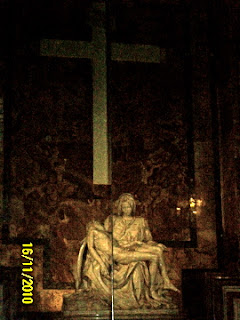Solemnity of Corpus Christi
Arguably the most popular topic for renaissance painters was the Madonna and Child. There are more paintings of our Blessed Mother holding her child, Jesus than probably any other saint or person. In almost all of those paintings, Mary is holding Jesus, and is looking down towards Him with love and wonder. Probably the most famous statue of the Blessed Mother is the Pietà by
Michelangelo. Currently housed in a chapel in the Papal Basilica of St. Peter in Vatican City, it shows the Blessed Mother holding the lifeless Body of her Son after He was taken down from the cross. She is still looking down towards Him, but this time with sorrow on her face.
In both the paintings of Madonna and Child, and the Pietà, Mary’s gaze is towards Jesus. She is focused on Him. And as we come to Mass today to celebrate the Most Holy Body and Blood of our Lord, Mary invites us to do the same thing: to gaze towards Jesus.
For cradle Catholics, the Eucharist might seem very familiar, maybe even not a big deal. But in the Eucharist, the Body and Blood, Soul and Divinity of Jesus Christ, we see the same Jesus that Mary held, and receive Him either on our tongue or in our hands. It is the biggest deal on earth, and the greatest treasure the Church has.
Jesus, on the night of the Last Supper, that we heard about in the second half of our Gospel passage today, instituted both the ministerial priesthood and the Eucharist, as His way of perpetuating the new Passover, no longer the angel of death passing over the house of the Israelites, but Jesus, the true Passover or Paschal Lamb being sacrificed so that we, His adopted brothers and sisters in baptism, would not have to suffer eternal death. Each time the Mass is celebrated, Jesus’ one, perfect sacrifice on the cross is made present to us again as we enter the ante-chamber, the narthex, as it were, of the perfect tabernacle in heaven. That is why, instead of the risen Christ, the crucified Christ should occupy the central place above the Tabernacle in the sanctuary: placed before our eyes in a prominent way should be the mystery of what the Eucharist recalls: the crucifixion.
But because this re-presentation of Calvary happens so frequently, as Catholics we can forget its power, and forget just how awesome it is to be able to come into the presence of Jesus Christ Himself. Our posture hopefully helps us to remember. We kneel during the Eucharistic Prayer, lowering our very bodies in adoration of the miracle of the bread and wine becoming the Body and Blood of Jesus. Not simply a reminder of Jesus’ Body and Blood, but the same Body that hung on the Cross; the same Blood that was poured out for our salvation in Jesus’ Passion. We even used to (and people are still allowed to) kneel to receive the Eucharist. There was something good about this, as it reminded our bodies that we are not worthy, and therefore lowered, before the presence of Jesus.
We should take as our model as we approach the Eucharist Mary, the Mother of God. Mary shows us how to love Jesus in the Eucharist. Mary shows us how to hold Jesus carefully as a mother with her child, in the Eucharist. Mary shows us that, to hold Jesus, we should be doing all that we can to say yes to Jesus, and being reconciled with Him in the Sacrament of Penance if we have, in some major way, said no to Him. As we celebrate Corpus Christi, may we rediscover a profound spirit of wonder and awe in the presence of Jesus, who each day around the world humbles Himself by changing bread and wine into His Body and Blood, Soul and Divinity in the Most Blessed Sacrament of the Eucharist.

